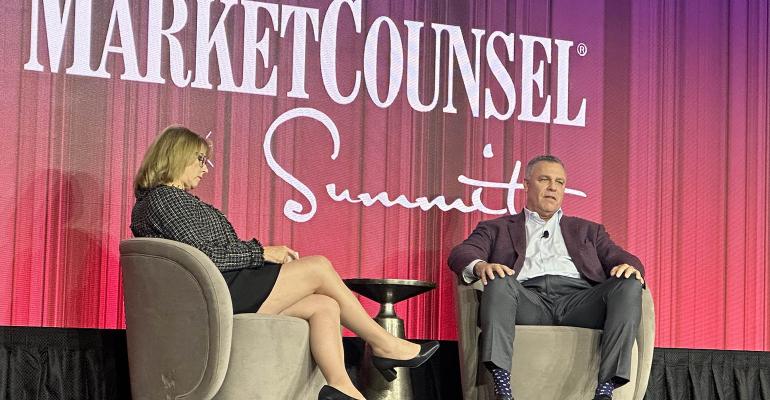Jim Dickson, who was terminated from his position as CEO of Sanctuary Wealth, the firm he founded in 2018, spoke publicly this week for the first time since his departure.
At the MarketCounsel Summit in Las Vegas, Dickson, who declined to comment on why he left, reflected on his time at Sanctuary, in particular his struggle to balance growth of new advisors joining with service to existing ones and the pitfalls of taking on capital partners.
Dickson, a former Merrill Lynch executive, launched Sanctuary in 2018 as a supported independence platform for advisors coming out of the wirehouses. It grew rapidly under his leadership into a national network of independent wealth managers, with $27 billion in assets and 300 advisors in 28 states. But in a surprise move in February, he was abruptly replaced by Adam Malamed, a former Ladenburg Thalmann executive and member of Sanctuary's board of directors, as CEO of the firm.
“I don’t regret anything I did at Sanctuary. It was an amazing run. So thankful for it,” Dickson said. “But the reality is, it didn’t end the way I wanted it to. That’s OK, you learn from that. You go on, and there will be other chapters and lessons learned.”
To accommodate the firm's growth and deal pipeline, Dickson raised professional capital in two rounds, the first being led by an investment bank. In 2020, after a long due diligence process of speaking to some 30 capital providers, the firm raised about $50 million from Azimut Group, a European asset management firm.
“That was the day Sanctuary had to become more professional. It wasn’t a startup anymore. It was a mid-cap,” Dickson said. “The reality was, by the time we closed that deal, we had almost used it all.”
Looking back, Dickson said as Sanctuary took on larger teams, existing advisors on the platform grew concerned about the level of service they would continue to see.
“We stayed true to our vision," he said. "Had a lot of people that fit, and proud of everybody that’s still there, and doing wonderful. But the reality is, we might’ve grown too fast, too quick.
“You feel you got to go get more capital; you got to go get more people," he said. "You got to make sure you’re serving the right people, and you got people knocking on your door wanting to know more about what you do. And that’s a really hard balancing act for a young, growing company.”
Dickson said he had to start fundraising almost immediately after the Azimut deal closed; and he was feeling the pressure, with nine or 10 advisor deals in the pipeline.
But with the Azimut deal, Sanctuary went through the entire process with an investment banking firm. They had many conversations, and both had a mutual understanding for what the mission and vision was and the direction the firm was going in the future.
With the second professional investment, Dickson admits, Sanctuary skipped that process.
“A lot of us, as we’ve raised capital and as we’ve grown, we don’t stop long enough and pause and reflect long enough to really understand what that means, until it means what it means,” he said. “It changes everything. You’ve sold freedom and flexibility as your value proposition to 300 advisors and $27 billion of assets. And now, as you raise capital, that’s exactly what you’re giving up, is your freedom and flexibility.”
As Sanctuary started thinking about raising the next $150 million, Azimut suggested talking to Kennedy Lewis Investment Management, a U.S.-based credit manager. And in July 2022, Sanctuary announced it had had closed on a deal with Kennedy Lewis to receive $175 million in financing in the form of a convertible note.
“We skipped the process. We skipped sitting at the table and saying to each other, ‘this is what I think is important. This is where I think we’re going. This is what I value,’” Dickson said.
And while Dickson said he has no regrets about his time at Sanctuary, he said he wished he would have slowed down before taking that investment.
"On one hand, you are racing toward that money to say, ‘Look I want to get this so we can close these deals so we can keep growing,’" he said. "On the other hand, if you skip the fundamental process of really having an investment banker run a process and have you look at multiple firms and have really a deep dive into the mission and the vision and the personalities. Everybody’s great when you’re dating. When you skip that, you’re at your peril.”
Dickson cautioned founders in the room to take things slower and have more control over the process.
“I want the message to be that you should play the game under control, and play the game comfortable with what your vision and mission is, and if at any moment you’re not sure, call time out,” he said.
“We skipped that process because the two investors already had a relationship and I thought it was going to be more of the same that we had with our old board to say, ‘Yes give us the money; we are going to do this.’ But then after we closed, we couldn’t get the money to do this.”
Dickson urged owners to take the time to have the deep conversations with capital providers about what they’re looking for and why they’re investing.
“If you think that they’re there because they want to participate in an investment that’s going to throw off unbelievable cash flow for a really long time and the real reason that they’re there is because they want you to sell one of their proprietary products, which makes you feel really uncomfortable, that marriage isn’t going to work very well,” he said.
A Sanctuary spokesman declined to comment on Dickson's remarks.





